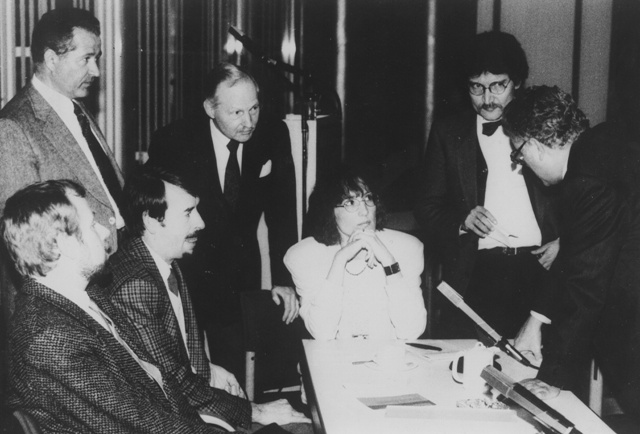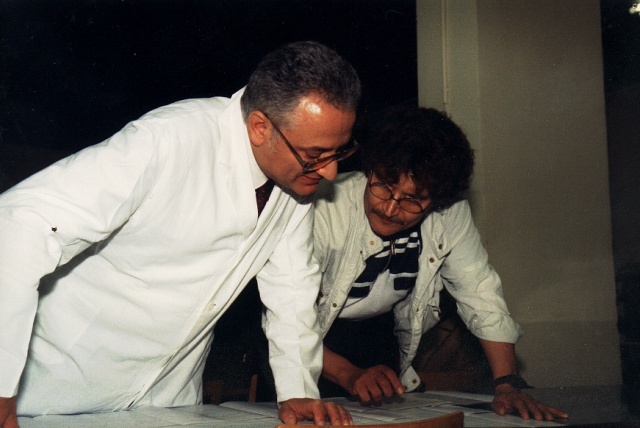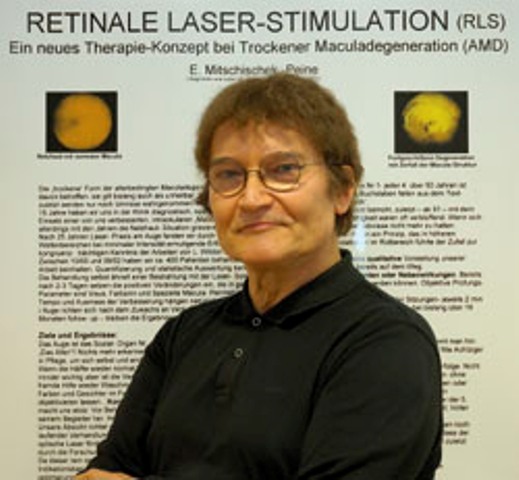

| Background |
| Albert Schweitzer |
| The musican |
| The artist |
| The ophthalmologist |
| Bibliography |
| Contact |
| Home (English) |
|
 |
Dr. E.Mitschischek |  |
|||||||||||||
|
|
||||||||||||||
The ophthalmologist
 The unplanned possibility to begin specialist training can, at the most, be paraphrased as follows: Being in the right place at the right time.
The unplanned possibility to begin specialist training can, at the most, be paraphrased as follows: Being in the right place at the right time.
The tradition-rich Ophthalmic Hospital at the University of Tübingen, which had had its own building since 1912, had just been subdivided into three equal, independent departments by the outgoing department head, Professor Harms — and this at a time of upheaval in our speciality: GOH Naumann....
First mass-produced artificial lenses, operative aesthetics was compulsory for this astonished assistant, diagnostic systematics, which helped avoid taking the wrong path even after decades and a clear didactic, which was supported by pathology: The “pathological guideline” as a model of a dynamic understanding of disease.
 Among the students of Meyer-Schwikeradt, Professor Wessing, who headed the retinology, the first laser cuts (the ”spine killer“, the “xenon bomb”, was still the method of choice for a long time).
Among the students of Meyer-Schwikeradt, Professor Wessing, who headed the retinology, the first laser cuts (the ”spine killer“, the “xenon bomb”, was still the method of choice for a long time).
Finally, the return of his former senior physician Laqua, who had developed the surgery of the vitreous humour with Machemer in the USA. I was able to assist him in most of his vitrectomies, a particular honour, for at that time automatic equipment was still very primitive, which meant that a certain amount of spontaneous intelligence and situational comedy was good for the operational success.
Finally, 18 months with Professor Kreissig: „minimal surgery“ and the first balloons...a hard school, for which I am still thankful. I am also still grateful to Professor Kreissig, who gave me my first appearance on the “scientific catwalk” with her invitation to present a lecture at the 72nd Congress of Württenberg's Ophthalomologist Association in April 1988 in Tübingen.
Professor Kreissig’s legendary teacher, Harvey Lincoff form New York, was a regular guest in Tübingen. His praise for the radiary 3 mm balloon of the young assistant, with handshake, remains an event for me, “Mr. M., that’s perfect”… and naturally professional commitment.”
And not to be forgotten, “Professor Authorn, equally brilliant as person and scientist; the epitome of that which we called “the spirit of Tübingen”.
Professor OA Völcker was a special role model for me — not only because he assisted during “my" first Cataract. — at that time still intracapsular. At a time of manually (not yet computer-) controlled perspective, in Professor Naumann’s Glaucoma Department, he forced us to realistically trace the papillae using a contact glass/lens … “eye training” of a special kind. In joint weekend duties he impressed and formed me with his scrupulous diligence in dealing with the patients.
The head of the Ophthalmic Hospital in Heidelberg made it possible for me, via his senior physician at that time, Dr. Holtz, who is now in Bonn, to make the first university presentation of our RLS method for dry AMD in 2003 (see below). It was also Professor Holtz who encouraged me to present the procedure at a scientific congress.
Highly trained and prepared, I was ready to guide the Eye Department at the Braunschweig City Hospital as senior physician into the new age of diagnostics and therapy from 1981 until the end of 1984. In December 1981 I met Dr. Zivojnovic from Rotterdam, who was developing modern silicone surgery at that time, privately at Professor Heimann’s during a small vitrectomy congress in Cologne. It was my “Damascus experience". Only after I had heard this unpretentious man, did I realize that I would only be “making eyes” in the future… He invited me to sit in on his operations regularly until January 1985, where I had the opportunity to absorb all of his efforts and results. In the first year, interest in his work was so limited that I basically had “private instruction” with him.
On the 16th of December 1982 we performed our first intervention with this method, and with success.
In order to be able to work without stress and intrigues, I took over an in-patient ward which was to be closed because of inefficiency at the Peine District Hospital. It was nonsterile and shared its quarters with the ENT Department.
(Before that in the spring of 1985, medical observation with Professor Dardenne in Bonn when he was still working at the University Ophthalmic Hospital and had just prevailed in the implementation of out-patient excision of cataracts in Germany.

The speakers at the Peine Retina Conference of 1989:
Professors:
Strik (Oldenzaal),
W.D. Ulrich (Leipzig),
G.Rieger (Wien),
W.Schrader (Würzburg), F.Dannheim (Hamburg),
S.Bopp (Lübeck),
Dr. E.Mischischek (Peine)
The district provided me with a new building for the surgical wing, which fulfilled all requirements. Except for the most difficult retinal interventions, everything was provided for, especially since I had contributed the diagnostic and operative units for the latter using leasing and credit.
From 1988 onwards we were regularly present as speakers at specialist conferences and in the literature in the service of our scientific associations—DOG, DGII and the Retinological Society. The close cooperation with Professor Ulrich’s department at the University of Leipzig from 1986, where the modern equipment and methods for early cataract detection and circulation research were developed, has proven beneficial for our own efforts in these areas up to the present.
The benefits of this co-operation were, e.g., the Peine Retina Conference in March 1989 with lecturers from 5 different countries.
From January 1990 we implanted an American patent, the so-called Macula Lens according to Koziol/ Peyman, which frequently provided very good reading results, but did nothing to change the deteriorating macula situation.
As a consequence, I continued my search until I discovered the principal of “retinal laser stimulation” (RLS), with which it is possible to achieve vision improvements practically overnight, without pain or scars in the dry form of AMD, for which there is no therapy to date world-wide—85% of the degeneration that occurs is "dry degeneration".
 More than 60% of our patients achieve normal reading capability; more than 30% security and independence in daily life.
More than 60% of our patients achieve normal reading capability; more than 30% security and independence in daily life.
The procedure was published for the first time in March 2003 in the „Augenspiegel“. In July 2003 it was presented at the Congress of the Retinological Society in Tübingen In February 2005 contribution in the health magazine “Visite” at the initiative of the NDR. In June 2007 a contribution at the annual meeting of the Retinological Society in Cologne.
”RETINAL LASER STIMULATION” – (RLS/LLLT)
a promising procedure for visual rehabilitation
in cases of ”dry” AMD
“The existing quantitative study was planned to be a sequel to the qualitative paper published in March 2003 in the “Augenspiegel”. It was submitted at the beginning of 2006 and accepted or publication in writing by the Editor-in-Chief (U. Lüdtke).
There has been no progress whatsoever in this matter since then.
Consequently, we decided on this mode (Internet) of publication so that the wall between those affected and professional “protectors of truth”, self-proclaimed experts and specialists could be penetrated.
The quantitative study is available here as pdf-file.
The legally responsible sufferer can test for him- or herself what will benefit him or her.
Indeed all relevant examinations and the first treatment are free of charge.There are no prepayments or obligations.
To illustrate our scientific efforts in the different areas of ophthalmology, the following bibliography is suggested.
The “Low laser therapy” (LLLT) is based primarily on the theoretical and experimental specifications of the Rubinov School in Kiev.
Although the methodology is being increasingly used therapeutically in some fields of medicine, only a few individual therapists (lone wolves), who are treated with suspicion, are to be found in the area of the most highly organized sense organs, the eyes and ears. We have been allowed to claim the intellectual property rights in the field of ophthalmology since the end of 2000. Since the middle of the 1990s, Dr. Wilden, an otologist in Bad Füssing, has focused his efforts on the theory and practice of LLL therapy and has published papers documenting his treatment successes of, e.g., tinnitus. His efforts gave me the possibility of making my first presentation of the “retinal laser stimulation” (RLS) in the scope of the 7th Symposium of the DA f P in October 2002 in my hometown, Dresden.
Here is a link to Dr. Wilden’s homepage: